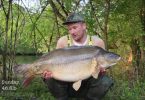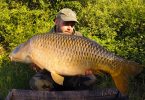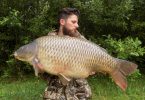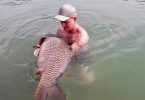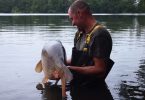As we shoved off from the dock at the foot of the boathouse ramp, and glided into the lifting veil of morning mist enshrouding the forest primeval, a pair of squawking, vividly painted red and blue macaws took flight – flapping eastward to greet the swelling dawn light. With a pull of the starter cord, we motored up and across rapids, and between the myriad islands that dappled the enchanted river – moving through a series of micro climates – at once warm and humid and then on to another group of islands where the air was cool and dry. Our quarry, the discus shaped pacu, beginning their early morning assembly in the deep, slow moving channels and pools, in search of insects at the water’s surface and buoyant fruit on its voyage down river.

Just 2 1/2 degrees off the planet’s equator, one is embraced by feelings of both privilege and awe – and a notion of time suspended for all eternity. Here was a place that had remained unchanged for millennia – shaped by the rise and fall of countless seasonal floods – soil anchored by ancient and majestic forest titans – home to a wealth of flora and fauna – and scores of as yet undiscovered species – aquatic and terrestrial.
I had found myself here by sheer good fortune. Ian Sulocki, one of IGFA’s representatives in Brazil, involved with teaching native fishermen accustomed to subsistence fishing, to guide for visiting recreational anglers, invited me to conduct a fly fishing course for the guides of the Xingu River Lodge. Located in the eastern portion of the Amazon basin, in the Brazilian state of Pará, the lodge sits atop a hill, 50 meters above the river’s bed – the Xingu, a tributary of the mighty Amazon River. Without a moment’s hesitation, I accepted Ian’s generous offer. Here was a chance to discover a whole new region ~ a unique wilderness, with a distinctive people and culture.

On spotting a school of pacu rolling on the surface, we cut the engine and gingerly approached, positioning ourselves with the electric motor, and began casting for fish no more than a meter distant from our boat. We worked the baits with light jerks, imparting only the slightest movement to the small flies, seeking to imitate surface swimming insects. Tethered to long fine leaders, we cast our flies into the school at distances of up to 20 meters as the mass of fish moved about in concert. We took a strike and the hooked pacu branco began to circle, swirl and contort like a wounded Frisbee, its blade~like profile slicing and cutting the water.
The Xingu is also home to the pacu curupeté, fished with small streamers in fast running water. When hooked, the pacu curupeté makes a signature leap from the water, followed by a quick descent through the rapids, stripping line all the way. Its larger and more voracious “cousin”, the pacu seringa can be found in the same habitat, however, this fish’s battling tactic is to take its fight to the river’s bottom, diving for cover and freedom.
As the arc of sun moved toward late morning, the pacu headed for deeper water and we headed off in search of tucunaré (peacock bass). Navigating the labyrinthine channels and rapids, we spotted black skimmer birds nesting along the many sandbars and beaches, or actively in search of a meal, flying close to the water’s surface.

One of the first things an angler discovers on arriving at the Xingu River Lodge is the character of the river. Situated in a region called the Volta Grande do Xingu (The Great Bend of the Xingu) at Belo Monte, its diverse waterfalls and rapids impede commercial fishing and navigation, creating a natural reserve. In June 2005 the region’s protected status was formalized through designation of the area as a sport fishing sanctuary, protected from development, by both state and federal environmental agencies. And the lodge itself enjoys an even greater privilege in that the 30 km stretch of river at its base is impassable due to cascading waterfalls at either extreme ~ rendering that segment of the waterway accessible only to guests of the lodge.

Much of the shoreline consists of sandy beaches, alternating with volcanic rock outcroppings – with the river dotted with endless numbers of islands, diverting the water’s flow into channels, pools, lakes and lagoons – some of which remain isolated as the seasonal floods recede.
This varied landscape permits all manner of fishing preferences – afloat, on foot, wading among the rapids, or simply anchored. Were its Eden~like setting not enough to attract the most avid of fly fisherman or naturalist, the sheer variety of exotic species to be caught within relatively short distances along the river, makes it a highly desirable setting for fly fishing.

The first three days of my stay were dedicated to instructing the lodge’s guides. It was a gratifying experience, being able to marry theory with practice and to see my eager students so readily adapt to fly fishing techniques ~ both as anglers and guides.
But I also wanted to partake of the bounty of the river. So on day 4, I took off in earnest on my quest for the famed peacock bass (tucunaré) of the Xingu – a little known species of this predator, quite different from others I had fished for in the past. For those accustomed to peacock bass fishing, locations surrounded by calm water are the most common settings in which to find these ambush predators. However, for the peacock bass of the Xingu, one is as likely to find them lurking on the edge of fast running water as in tranquil pools. For lovers of fly fishing, there’s nothing better than working the turbulent patches of a river. And were it not for the exotic species encountered here – tucunaré, bicuda, pacu – and the water temperature – the fast running, shallow water over a rock covered bottom – holds a lot in common with trout fishing.

We landed our boat and taking to the shoreline we stalked peacock bass along the calm waters between the rocks and sandy beach, seeking out sight casting opportunities in the clear shallows. If not located in schools, fish are almost always found in pairs. A rapid cast behind a hooked specimen generally draws out its mate, triggering its attack behavior as well.

Although not yet classified, there is common agreement in the scientific community that the peacock bass of the Xingu River represent one or more unique species. In the region they are known as yellow tucunaré. Despite an appearance similar to that of Cichla monoculus, it displays characteristics quite different from those of the C. monoculus, common to the South Central region of Brazil. The yellow peacock bass of the Xingu River as a juvenile is dark, with numerous spots.
As the fish grows in size, the spots begin to disappear, leaving in their place up to 10 bands or stripes.

As an adult the fish loses all of its bands and turns completely yellow.

There are currently 5 classified species of peacock bass found in Brazil. However, there are believed to be at least 12 distinct species of this Cichlid to be found in the Amazon. A revision of the genus is currently being undertaken by the Swedish ichthyologist, Dr. Sven Kullander, in collaboration with Dr. Efrem Ferreira, of the Brazilian National Institute of Amazon Research (INPA).
The peacock bass of the Xingu can reach up to 11 pounds. Despite their weight class, with an upbringing in the swift currents and rapids of this river, they fight like giants. And they’re here in abundant numbers.
After a dinner of finely prepared local cuisine, a cornucopia of local tropical fruits and a pleasant gathering of guests, our host entertained us with virtuoso guitar solos and vocals of Brazilian classics – bossa novas, sambas and regional tunes. Retiring to our air conditioned bedrooms I couldn’t help but dwell on the next day’s quest – the barracuda~like bicuda and the saber tooth payara.
On day 5 I rose before daybreak, itching to get on the water. My anticipation was duly rewarded with a non~stop barrage of fishing action.
We first set out for bicuda (Boulengerella spp) – aggressive, sniping predators whose dramatic, lightning bolt attacks are only exceeded by their acrobatic leaps and long runs. Fitted with hard bony mouths, they make setting the hook a challenge.

Among one of the strangest of nature’s adaptations is the payara (Hydrolycus scomberoides). It is equipped with two large fang~like teeth protruding from its mandible, which fit neatly into sockets within its upper jaw. It is as fragile as it is ferocious. When hooked firmly it will take to the air, but its survival depends upon a rapid release.
For the light equipment enthusiast #2 or #3 rods can be used in pursuit of a number of smaller game fish species matrinxã, jacundá, lambari and piaba. Using dry flies, small streamers, or mini poppers, schools of these species can often be found in 1 to 1 ½ meters of water.

And for anglers who simply can’t resist packing their bait casting or heavy tackle for bottom dwelling denizens ~ several species of leather skinned leviathans, rays and croakers can be found in sizeable numbers and near record sizes.
At the end of our 6th day, I was overcome by that comfortable, relaxed kind of tired feeling. One characterized by contentment, satisfaction and fulfillment. It was time to go home. I knew I had experienced a rather special place that would draw me back again and again.
Marco Valerio da Costa is the owner/operator of FLY CAST Fly Fishing School located in São Paulo, Brazil.
Tackle
You’ll want to bring your own equipment. The Xingu River Lodge is remotely located and is not equipped to outfit anglers. Listed below is the gear I brought with me, but I’ve also provided a listing of other equipment you might consider taking along.
Rods #2 ~ #4 for small fish (lambari, piaba, jacundá, matrinxã and small peacock bass) light equipment is highly recommended)
Rods #6 ~ #8 for bicuda, cachorra, pacú and peacock bass
Lines floating and intermediate, compatible with heavy tackle foating compatible with light equipment
For this fishing trip I used the following:
Rod: Sage Xi2 ~ #8 Lines: TT8~I Bermuda Taper (Royal Wulff) and WF8F Bass Taper (Rio) Reel: G. Loomis – Venture 7
Rod: Sage LE ~ #6 Lines: TT6F and WF6I (Rio – Salt Water) Reel: Ross
Rod: Sage VPS ~ #4 Line: WF4F Performance Taper Reel: Teton
Rod: Sage Ds2 ~ #2 Line: Quiet Double Taper – 2F Reel: Teton
Lures: a variety of streamers for payara, peacock bass and bicuda; poppers,divers and sliders for peacock bass; grasshoppers and small coconuts for pacú;small streamers, mini poppers and large dry flies (e.g., Stimulator, Hopper)
Recommended Additional Equipment for Species
|
pecies |
common name |
scientific name |
fly fishing |
|
tucunaré |
peacock bass
|
Cichla spp |
Rod type ~ #8 – 10 weight for most species Reel type – with 100 yds. of backing Line – #8 floating; 10 ft. sink tip line; 4 – 6 ft. leaders; 30 lb. shock tippet and wire leaders Lures – Peacock bass: streamer flies up to 11 cm (imitating small fish – white with red head; green upper/white lower; green upper/white middle/red lower); poppers sizes 2/0~4/0 in red/white, blue/white and green/white. Also, streamers sizes 2/0~4/0, all with a white belly and plenty of silver flash in red, blue or green. Payara: streamers the same as for Peacocks, with wire leader and very sharp hooks. Piranha: streamers in sizes 2 – 2/0 in blue or green with heavy silver flash.
|
|
payara/ cachorra |
saber tooth dogfish |
Hydrolycis scomberoides |
|
|
piranha/ black prianha |
|
Serrasalmus serulatus/ Serrasallmus rhombeus |
|
|
bicuda pacu |
|
Boulengerella sp |
|
|
pacu |
|
Piaractus mesopotamicus |
Lures ~ streamer flies, and worm~like and fruit~like lures; poppers sizes 4~8, in chartreuse or orange (imitating the fruit food sources.) They will occasionally take streamers sizes 1/0~ 2/0, all with white belly and silver flash in yellow, red, blue or green. |
|
corvina/ pescada~do~piauí |
silver croaker |
Plagioscion squamosissimus |
Rod type ~ Reel type ~ Line ~ Lures ~ streamers fished deep |
|
pirarara |
redtail catfish |
Phractocephalus hemeliopterus |
Lures – natural bait is preferred for catfish. Hooks in sizes 4/0 – 10/0 are required for different species, with wire leaders and sliding sinkers from 1~3 oz. |
|
piraíba |
|
Brachyplathystoma filamentosum |
If You Decide To Go
The Xingu River Lodge operates between July and November. From the U.S., the principle Brazilian gateway city is São Paulo. Regular daily flights operated by most U.S. and Brazilian international carriers are available from major U.S. cities. I highly recommend TAM Brazilian Airlines as the carrier of choice. With two daily flights from Miami and service from New York’s JFK, and some major European cities, they not only have the most modern fleet in Latin America, with the most extensive route structure within Brazil, they are also a oneworld partner of American Airlines.
The lodge offers an 8~day/7~night package with 6~full days of fishing. Guest arrivals are scheduled for Thursdays, with departures on Thursday of the following week.
From São Paulo, travelers will board connecting flights to Belém, where they will take a 65 minute flight to Altamira. Transfers to the lodge are available from Altamira via air conditioned van (1 hr. 45 min.), or optional air taxi (15 min.) to the lodge’s airstrip.
Not to be missed is Belém and Environs, for both its history, culture and natural attractions. A 2 to 3 day stay in the capitol city of Pará prior to visiting the lodge will provide an experience of a lifetime. The sights, sounds and flavors of this truly unique Amazon city are to be found no place else on earth.
For additional information and reservations for the Xingu River Lodge contact:
HIGH HOOK FISHING TOURS: http://fishinginamazon.com/
Text and photos by Marco Valerio da Costa
(Translation: Mark E. Ulrich)



